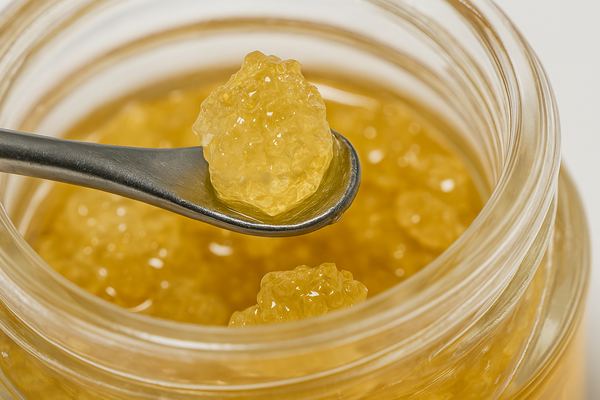Why Are Cannabis Diamonds the 'Golden Idols' of Extracts?
Apr 11, 2025
Cannabis concentrates have come a long way from the days of simple hash and kief. These days, one of the most talked-about—and eye-catching—concentrates on the market is cannabis diamonds. With their crystal-clear appearance and sky-high potency, it's no surprise they're being called the "golden idols" of the extract world.

But what exactly are cannabis diamonds? In short, they’re crystalline structures made up of nearly pure THCa (or CBD), extracted and refined through a meticulous process that involves solvents, temperature control, and a whole lot of patience. This intricate process, akin to the art of crafting a fine jewel, results in shimmering, rock-like formations that can test at up to 99.9% purity.
Their popularity isn’t just about looks, though; diamonds offer intense effects that are strong, immediate, and long-lasting. This level of potency appeals to seasoned users and connoisseurs alike, sparking a curiosity to experience these effects. Whether dabbed solo or paired with terpene-rich sauce for a full-spectrum hit, these concentrates literally set the bar.
To better demonstrate why diamonds are so beloved, let’s break down how they’re made, what makes them special, and why so many users reach for diamonds over everything else.
What Are Cannabis Diamonds?
Cannabis diamonds are crystalline isolates of cannabinoids—most commonly tetrahydrocannabinolic acid (THCa), though cannabidiol (CBD) diamonds are also produced—formed through post-processing of high-purity extracts. These isolates represent some of the most refined concentrate formats on the market, often boasting purity levels between 96% and 99.9%.

In the case of THCa, these diamonds remain non-psychoactive until heat is applied, which converts the acid form into active THC through decarboxylation. Once activated, the effects are not just strong—they’re intense, immediate, and long-lasting, making diamonds a clear favorite among high-tolerance users and seasoned concentrate consumers.
Visually, cannabis diamonds live up to their name. These solid crystalline formations can range in size from small granules to large shards and often appear translucent white, though they may take on a golden hue if residual terpenes are present. That slight coloration is particularly common in diamonds sold with sauce or other terpene-rich fractions, adding to their visual and olfactory appeal.

Their rising popularity is no accident. With the cannabis market’s ongoing shift toward cleaner, more potent, and highly repeatable experiences, diamonds have carved out a niche at the top of the concentrate hierarchy.
Consumers looking for precision dosing, maximum cannabinoid delivery, and a premium aesthetic are gravitating toward these high-purity isolates. For manufacturers and processors, this demand reflects a broader trend: potency and purity are no longer luxuries—they're baseline expectations to have.
The Crystallization Process: From Biomass to Diamond
The path to producing high-quality cannabis diamonds starts well before the crystals begin to form. It begins with biomass selection, where either fresh frozen flowers preserve peak terpene levels for live resin-based diamonds or cured material for processors, prioritizing throughput and flexibility. The choice of input sets the tone for everything downstream.
Extraction typically involves light hydrocarbons like butane or propane, chosen for their low boiling points and superior terpene preservation. These solvents are ideal for producing the kind of terpene-rich crude that’s well-suited for diamond formation, especially when targeting full-spectrum outputs like diamonds and sauce.
After extraction, the resulting oil undergoes a light purge to remove the bulk of residual solvents while intentionally retaining the THCa and volatile aromatic compounds. At this stage, the extract is in a supersaturated state, which is primed for crystal formation but still fluid enough to allow for molecular movement.
The supersaturation phase is where the transformation begins. Here, the extract is stored in sealed vessels under carefully controlled conditions (typically low and steady temperatures with minimal agitation) to encourage the slow, stable formation of THCa crystals.
Time is the critical ingredient here. Most crystallization cycles take anywhere from two to six weeks, depending on solvent ratios, cannabinoid concentrations, and how dialed-in the environmental controls are.

Due to their density, the crystals form on the bottom, separating from the viscous, terpene-rich layer known as the sauce. This two-part product is either packaged as-is or further processed. In most cases, diamonds are separated and undergo a final purge to ensure the complete removal of residual solvents.
Because cannabinoids like THCa have higher boiling points than terpenes, this step is often longer and slower, using gentle heat and vacuum to preserve structural integrity without degrading the product. Consistency throughout the pipeline hinges on the interplay between process control and upstream material quality.
Closed-loop systems are standard for safety and precision, while post-processing hardware, from filtration columns to purge ovens, must be dialed in to prevent contamination or yield loss. At this stage, your filter media choices can directly impact product quality and resulting extract performance.
Removing pigments, fats, and other impurities early in the process doesn’t just enhance clarity—it’s often the determining factor in whether a batch will crystallize cleanly or fail to form at all.
Color Remediation and Filtration: The Foundation of Clarity and Quality
In diamond production, purity isn't just a chemical metric—it's visual, functional, and commercial. The cleaner your extract, the better your diamonds, and that starts upstream with proper color remediation and filtration.

Even though THCa diamonds are isolates and don’t retain many original plant compounds, the extract’s initial composition plays a pivotal role in whether crystallization happens smoothly or stalls entirely.
Color remediation is more than just about aesthetics, though the goal of producing light-hued, glassy diamonds certainly plays into consumer appeal. What’s really at stake is removing the compounds that can interfere with nucleation and growth: pigments like chlorophyll, and residual pesticides or fertilizers.
Left unchecked, these contaminants can inhibit crystallization, introduce off-flavors or odors, and degrade final product stability. In worst-case scenarios, poor filtration can lead to failed COAs or batches that never yield usable crystals at all.
Filtration media used in CRC setups typically includes a blend of bentonite clay, silica, and activated carbon. Each component serves a targeted function: clays effectively trap polar compounds and moisture, silica excels at scrubbing chlorophyll and some heavy metals, and carbon can reduce oxidation by removing color bodies and some volatile organics.
Depending on the biomass and extraction method, operators may dial in different media blends to optimize throughput without stripping desirable compounds or affecting yield.
It’s worth underscoring that even though diamonds are refined isolates, the groundwork for quality is laid far earlier in the process. A clean extract won’t just crystallize faster—it will deliver a more stable, shelf-ready product.
Consumer Demand: Why Diamonds Dominate the Premium Shelf
Cannabis diamonds have rapidly earned their place at the top of the concentrate hierarchy, showing up across dispensary menus as one of the most sought-after products for both recreational and medical users.

What was once a niche, boutique extract has evolved into a staple of premium-tier offerings, thanks to its combination of ultra-high potency, clean aesthetics, and perceived refinement. In an increasingly saturated market, diamonds stand out above the competition.
At the core of their appeal is purity, as THCa diamonds regularly test between 96% and 99.9% purity, with CBD diamonds offering similar levels of cannabinoid isolation. Their level of refinement is unmatched by other popular formats like shatter, wax, sugar, or even live resin, which tend to fall in the 60–90% range depending on the processing method used and resulting cannabinoid content.
This consistency allows medical users to do more controlled dosing with minimal interference from secondary compounds. For recreational consumers, the post-decarboxylation high is intense and fast-acting, which is ideal for those with higher tolerances or looking for maximum impact from a small volume.
Aesthetics also play a role; a well-formed diamond's crystal-clear or snow-white structure immediately signals purity and sophistication to the consumer, much like premium glassware or finely cut gemstones. The look alone signals premium quality, reflecting pricing ranging from ~$60 to $150+ per gram depending on their composition and particular branding (more well-known, established brands can often command a higher premium).
Ultimately, diamonds are more than just potent—they’ve become symbolic of quality in the extract space. As consumer awareness continues to sharpen and demand clean, high-performance products grows even further, diamonds are one of the most effective ways to meet those expectations and justify a premium price point.
Looking at Diamonds as the Pinnacle of Precision Extraction
Cannabis diamonds represent the intersection of science, craft, and consumer demand—offering a product that is as visually impressive as it is chemically precise.
From carefully selected biomass and solvent control to tight environmental parameters and advanced filtration, every step in the diamond production process reflects the industry's push toward cleaner, higher-performing extracts.
Even as the market leans further into full-spectrum and whole-plant formulations, diamonds remain at the top of the premium shelf thanks to their purity, predictability, and undeniable shelf appeal. That level of quality doesn’t happen by accident. No matter the end product, it all starts with a clean run with efficient filtration systems and specialized media that meet modern production standards.
If you want to dial in your process and elevate your extract game, Media Bros has the filtration solutions to help get you there. Our team is ready to help you choose the right media for your specific operation—whether you're focused on speed, selectivity, or simply superior color remediation.
Contact us directly at sales@mediabros.store or call 1-(503)-308-7138 to learn how we can support your extraction goals with products engineered for precision and performance.






